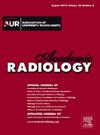What Program Directors Think About Resident Education: Results of the 2023 Spring Survey of the Association of Program Directors in Radiology (APDR) Part II
IF 3.8
2区 医学
Q1 RADIOLOGY, NUCLEAR MEDICINE & MEDICAL IMAGING
引用次数: 0
Abstract
Rationale and Objectives
The Association of Program Directors in Radiology (APDR) administers an annual survey to assess issues and experiences related to residency program management and education. Response data from the 2023 survey provides insights on the impact of COVID-19 on resident recruitment (Part I) and education (Part II), which can be used to facilitate planning and resource allocation for the evolving needs of programs and their leadership.
Materials and Methods
An observational, cross-sectional study of the APDR membership was performed using a web-based survey consisting of 45 questions, 12 of which pertain to resident education in the post-pandemic era and are discussed in Part II of a two-part survey analysis. All active APDR members (n = 393) were invited to participate in the survey.
Results
The response rate was 32% (124 of 393). Results were tallied using Qualtrics software and qualitative responses were tabulated or summarized as comments.
Conclusions
The primary challenges to resident education are faculty burnout, rising case volumes, and remote instruction. However, most program leaders report that in-person readouts are much more common than remote readouts. The ability to offer both in-person and remote AIRP sessions is viewed positively. Most program leaders require Authorized User certification, although many do not think all residents need it. Assessment of procedural competence varies by the type of procedure and is similar to graduates’ self-assessment of competence.
项目主任对住院医师教育的看法:放射学项目主任协会(APDR)2023 年春季调查结果(第二部分)。
理由和目标:放射学项目主任协会(APDR)每年都会进行一次调查,以评估与住院医师项目管理和教育相关的问题和经验。2023 年调查的回复数据提供了 COVID-19 对住院医师招募(第一部分)和教育(第二部分)的影响,可用于促进规划和资源分配,满足项目及其领导层不断变化的需求:对APDR成员进行了一项观察性横断面研究,采用网络调查的方式,调查包括45个问题,其中12个问题与后流行病时代的住院医师教育有关,将在调查分析两部分的第二部分进行讨论。APDR的所有现任成员(n = 393)都被邀请参与调查:答复率为 32%(393 人中有 124 人)。使用 Qualtrics 软件对调查结果进行统计,并将定性回答制成表格或总结为评论:结论:住院医师教育面临的主要挑战是教师职业倦怠、病例量增加和远程教学。然而,大多数项目负责人都表示,面对面授课比远程授课更为常见。同时提供面对面和远程 AIRP 课程的能力受到好评。大多数项目负责人都要求获得授权用户认证,尽管许多人认为并非所有住院医师都需要。程序能力评估因程序类型而异,与毕业生的自我能力评估类似。
本文章由计算机程序翻译,如有差异,请以英文原文为准。
求助全文
约1分钟内获得全文
求助全文
来源期刊

Academic Radiology
医学-核医学
CiteScore
7.60
自引率
10.40%
发文量
432
审稿时长
18 days
期刊介绍:
Academic Radiology publishes original reports of clinical and laboratory investigations in diagnostic imaging, the diagnostic use of radioactive isotopes, computed tomography, positron emission tomography, magnetic resonance imaging, ultrasound, digital subtraction angiography, image-guided interventions and related techniques. It also includes brief technical reports describing original observations, techniques, and instrumental developments; state-of-the-art reports on clinical issues, new technology and other topics of current medical importance; meta-analyses; scientific studies and opinions on radiologic education; and letters to the Editor.
 求助内容:
求助内容: 应助结果提醒方式:
应助结果提醒方式:


